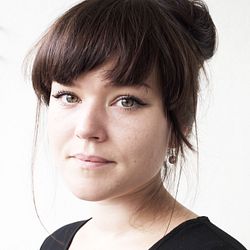Pressmeddelande -
Tove Jansson is presented in a major exhibition at the Gothenburg Museum of Art
Paintings, spot-on satire and rarely shown photographs will be exhibited side by side with Moomin illustrations and comic strips in the major spring exhibition at the Gothenburg Museum of Art, featuring the art of Tove Jansson. Explore a playful scenery composed of islets, caves and looming forests. Get an in-depth view of a nuanced body of work that is more relevant now than ever before. Join us in 2017 for an eventful spring at the Gothenburg Museum of Art!
The major project of the Gothenburg Museum of Art in 2017 is a solo exhibition featuring the work of the Finland–Swedish artist Tove Jansson – one of the most beloved artists in Scandinavia. The exhibition presents Jansson’s parallel careers as a visual artist, illustrator, caricaturist, cartoonist and creator of the world famous Moomin figures. It offers the opportunity to get to know a versatile oeuvre and experience Tove Jansson’s fascinating visual world in a playful scenery inspired by her depictions of nature. During the exhibition period, an extensive program of in-depth talks, guided tours and lectures will take place, as well as a large number of activities for children and young people.
-Tove Jansson was a keen observer of her time and questioned many of its conventions. Her art contains a deeper message about how important it is to question and constantly examine the world with curiosity and an open mind. The Desire to Create and Live is the most comprehensive presentation of Tove Jansson’s work ever made in Sweden. It is highly gratifying for the Gothenburg Museum of Art to emphasize Tove Jansson’s work as a visual artist. This was the most important aspect of her career for her personally, but it was often overshadowed by her role as a revered author of children’s books, says Anna Hyltze, Head of Department.
An artist with integrity and a love of work
In her life and work, Tove Jansson (1914-2001) shows incredible talent and versatility. She lived a rich and interesting life, often going against the prevailing attitudes of the time, with great integrity and a love for her work. As a visual artist, she was a colorist who admired Matisse, and a monumental painter who mastered the large format. As an illustrator, her sure and virtuoso use of the line made her one of the geniuses of her time. In her exhibitions and commissions, Jansson demonstrated that she mastered many different techniques. Portraits, and especially the self-portraits, make up an interesting part of her artistic production. These signal autonomy and independence – crucial values for her. A large part of Jansson’s paintings comprise interiors, still lifes, and landscapes in which oceans and islands play a major role.
Tove Jansson’s painting and her career as an artist were most important for her, but it is was through the internationally renowned Moomin characters she achieved fame worldwide. Tove Jansson wrote and illustrated the Moomin stories for both adults and children. They are complex in many ways and represent a complete philosophy of life. In the stories, emotions and contrasting themes such as frightening and secure, unknown and familiar, threatening wilderness and the warmth of home, are always present. From the beginning, writing and imagery were of equal importance and made equal narrative contributions.
A focus on the expanded family
Against the backdrop of the situation in Europe and the world today, Tove Jansson’s art and stories are more relevant than ever. Diversity and tolerance run through her entire production. Focus is on the family – both the artist’s own family and the Moomin dynasty – and the door is always open for those seeking shelter or guidance in life. Tove Jansson’s art reflects both human diversity and her profound understanding of it.
A scenic journey from the archipelago to the forest
Life in the Finnish Pellinge archipelagoand a passion for the sea were important sources of inspiration in everything Jansson created. This is why the scenery in the exhibition moves from a stylized archipelago onward to a dense, forest-covered landscape. The forest is taking shape on the walls of the lower Étage exhibition area. This contemporary homage to Tove Jansson’s book Who will comfort Toffle is painted by the Gothenburg-based graffiti artists SCEB (Camilla Boström) and OLLIO (Jonatan Josefsson). The murals give the public an idea of how Tove Jansson, along with other Nordic artists in her generation like Ingrid Vang Nyman, Ib Sprang Olsen, Poul Ströyer and Egon Mathiesen, used children’s books as an arena for a new aesthetics and how important this turned out to be for the communication of modernist visual expressions to a younger audience. The scenery, designed by the museum technician Arthur Ragnarsson, also points to the future and shows that Jansson’s style still inspires the present generation of young artists.
An in-depth view of Tove Jansson in the catalogue
The exhibition is accompanied by a catalogue that elucidates the many different aspects of Tove Jansson’s oeuvre. The authors are Dr.Tuula Karjalainen, curator of the Jubilee exhibition at Ateneum, Boel Westin, professor of the History of Literature, Paul Gravett, British journalist and cartoon expert, and Sir Frank Cottrell-Boyce, English screenwriter and author of children’s books. The catalogue provides in-depth knowledge about Jansson and functions as an educational tool in the exhibition. It offers a rich visual presentation of many of the works included in the exhibition.
The exhibition is produced by Ateneum Art Museum/The Finnish National Gallery with exhibition design and a comprehensive program of educational activities created by the Gothenburg Museum of Art. The exhibition’s educational program is supported by the Sten A Olsson Foundation for Research and Culture, and Göteborgs Barnhus Stiftelse, (The Foundation of the Gothenburg Children’s Home) through the society the Friends of Children’s Book Illustrations.
Contact
Helene Karlsson, Communicator, +46 (0)31-368 35 07, helene.karlsson@kultur.goteborg.se
Anna Hyltze, Head of department Exhibitions, Collections and Education, +46 (0)31-368 35 20, anna.hyltze@kultur.goteborg.se
Isabella Nilsson, Museum Director, +46 (0)31-368 35 01, Isabella.nilsson@kultur.goteborg.se
Philippa Nanfeldt, Curator for Art Education, +46(0)31- 368 35 05, philippa.nanfeldt@kultur.goteborg.se
Ateneums partners:

Relaterade länkar
Regioner
The Gothenburg Museum of Art has one of the foremost art collections in Northern Europe. Works by masters such as Rembrandt, Picasso and van Gogh are shown side by side with works by contemporary artists such as Charlotte Gyllenhammar, Klara Kristalova and Cajsa von Zeipel.

